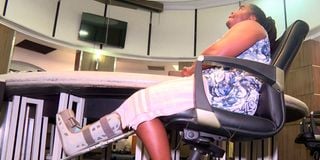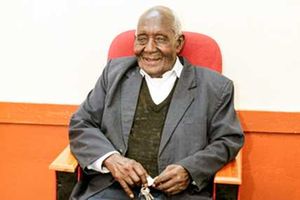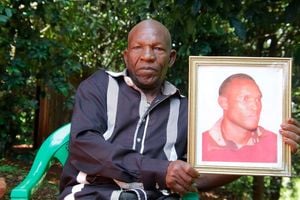How a staircase fall left Faith Kanyaa depressed, in pain and needing Sh300 million

Since 2019, Faith Kanyaa has undergone more than four leg surgeries, got into debt, been called a cripple, threatened with firing and literally lost the ability to sleep.
"When I fell down the stairs five years ago, I didn't know that I, Faith Kanyaa, would be given a new identity. If anything, I knew that the worst thing that could happen was that I would break my leg. My life took a new turn and I now live with a disability. I was later diagnosed with depression.
Since 2019, I have had more than four leg operations, gone into debt, been called a cripple, threatened with redundancy and literally lost the ability to sleep.
Post the fall, I went about my life as usual, until pain struck and my right foot became swollen.
I went to one of the hospitals in Machakos County, where an X-ray scan was recommended. The scan showed that I had a first metatarsal fracture in my foot at the sesamoid bone. My leg was put in a plaster cast to hold the fracture in place while the bone healed.
The doctor also advised me to avoid movement to allow the foot to heal and go back after two months for a check-up. However, despite taking the rest, the pain never subsided and I ended up going back to the hospital before the two-month period expired.
Read also: When childbirth leads to lifelong tears
The first plaster cast was removed and replaced with a tighter one. Five times, my right leg was put on a plaster cast, but the pain persisted, and the fractured part remained unhealed. It didn’t matter that I was on total bed rest.
Towards the end of that year, the doctor advised me to undergo Magnetic Resonance Imaging (MRI), a noninvasive medical imaging test that produces detailed images of almost every internal structure in the human body, including the bones.
I visited two Nairobi hospitals, did two scans and received two co-related reports that showed the fracture had not healed. It seemed as though my body did not have the ability to heal a fracture.

Faith Kanyaa during an interview at Nation Centre on May 16, 2024.
I remember celebrating the New Year in pain. In February of that year, the doctor I was seeing at the Machakos hospital suggested that since the bone was not healing, it would be better to remove it. He assured me that by July of that year, everything would have gone back to normal.
On March 20, 2020, at the peak of the pandemic year, I was admitted for a sesamoidectomy surgery to remove the incompatible bone.
But afterwards, the surgical area bled so much and left a wound that took nine months to heal.
Because of travel restrictions, a nurse who was my friend would come home to clean and dress my wound, and when necessary, give me pain injections.
That same year, I underwent the second surgery when the affected foot developed tenosynovitis (inflammation of the protective sheath that surrounds foot tendons) and oedema (build-up of fluid in the body which causes the affected tissue to swell.) A bone marrow surgery was also done, as well as decompression therapy to reduce the inflammation on the foot nerves, but there was no improvement.
That same year in November, I went to Aga Khan Hospital in Parklands and narrated my medical history to the pain specialist, who suggested a surgical procedure on some nerves to decrease the pain. The next day I was wheeled to the theater for a nerve block procedure.
Admitted for two months
The foot became numb for two days, allowing me to step and stand, and then the pain was back. This time I also developed gastritis and was admitted for two months.
The year rolled over, and I went back to Aga Khan Hospital, where we tried physiotherapy, but it never worked out because I was unable to walk. In February 2021, I got admitted again and underwent nerve and spinal blocks again but they never helped.
I became desperate, stopped going to Aga Khan and visited Kenyatta National Hospital to see a neurologist who prescribed drugs and gave me another appointment. Depressed and desperate, I kept calling people to ask them to refer me to a good orthopedist.
I eventually got one and he suggested we do an acupuncture. It was, however, very expensive, and I could not afford it. He sent me to do X-ray and MRI scans, which showed that I had fluid in my foot and a foreign object like a thread, probably from wound dressings. This was in May 2021.
He suggested a surgical procedure to drain the fluid and clean the wound. The gastritis I had developed earlier worsened, with migraines making a show. I was discharged, and we went back to dressing the wound amidst unending pain.
A month later, I got admitted again and was given a drug called Pamidronate, a strong painkiller often administered to cancer patients.
I went to Coptic Hospital in October 2021, where doctors suggested we do a biopsy to rule out the presence of cancer. When the results came out, they said there was no cancer, but that I had chronic inflammation in the soft tissues in my legs.
The doctor recommended that we go in for theatre and do a nerve ablation to destroy nerves in the area of pain. But that never worked, and I was back to doing dressings as an outpatient.
Splitting headaches
By the time 2022 was rolling in, I was still in pain, unable to move without crutches and still struggling with splitting headaches.
I saw other doctors after that, who said I had inflammation of the soft tissues. Some offered to do bone drilling procedures, but I couldn’t afford them as my medical insurance had run out at that time. I made a lot of calls but didn’t get any help and I had to go back home with a lot of disappointment.
I went back to work, only for a colleague to call me a cripple, and for a supervisor to scold me and call me ‘obsolete and of no more benefit to the organisation’.
At times I get to work at 11 or noon, yet I am always ready by 9.30am because I have to look for someone to take me to work.
I majorly rely on my tuk-tuk guys to pick me up and drop me off, and because I pay them at the end of the month, they prioritise those who pay in cash. Because of this, it can take two to three hours for them to show up.
That is when depression kicked in. It is hard. I had nothing. I had run out of money as I was moving from one facility to another.
I admit I had not been productive at work. But they had not shown an interest in what had been making me fail to deliver.
The bitterness festered. I didn’t feel like talking to anyone. I ignored all phone calls and when someone texted to see how I was doing, I wouldn’t respond.
Brushing my teeth
I couldn’t go anywhere and had no friends. If I wasn’t in the hospital, I was in my house. Eventually, I stopped going to work.
My son was in boarding school then. I couldn’t eat well, stopped bathing, would go for days before brushing my teeth and I also stopped doing my hair. That was the time I lost all ability to sleep unless I took antidepressants.
I wished to die. I overdosed myself three times to end it all but woke up the next morning. I reported my suicide attempts to one of my doctors, who got me into therapy.
Soon after, I met orthopaedic doctors who suggested an amputation, but they couldn’t guarantee that the pain would disappear.
This was 2023 when I was visiting different orthopaedics, and taking a combination of treatments from an orthopaedic surgeon, a pain specialist and a neurologist. I decided to exhaust all options before losing my leg.
The last option that I have yet to try is going to India. I want to get myself healed, but I don’t want to lose my foot.
I have been in contact with doctors from different hospitals in India and sent them copies of my MRI scans and even though their opinions co-relate, everyone has their own opinion and they need me to be physically present before they make a final decision.
I have been put on all the best and strongest antibiotics, painkillers, both orals, injections and infusion medication. Most of my medications are opioids, drugs that I take to subsidise the longstanding foot pain.
I am still in throbbing pain despite all these. Recently, I was diagnosed with Chronic Regional Pain Syndrome which makes it difficult to walk without the need for any kind of assistance. I move with the help of crutches.
This situation has affected me literally in everything. I have had traumatic stigma post the recurrent surgeries.
I face a lot of challenges when performing duties, sometimes with no privacy at all. My financial stability came to a standstill on medical grounds, and I have lots of debt.
I have gone back to work but I am not productive. At times no one understands me, and I find myself completely alone. I have not been active socially because moving around is still a challenge.
But I promised I wouldn’t give up on myself again and I want to live for myself and my child. I am a civil servant, but I don’t have money. And now that I don’t want to completely give up, I have reached out for help. I started looking for money last year and formed WhatsApp groups asking people to contribute. This will allow me to explore other options in India.
Since 2023 I have been fundraising, but I am yet to reach the target of Sh300 million, which is needed.
I am, however, still hopeful that all will be well. I pray that God will give me the strength to live and to fight more.





